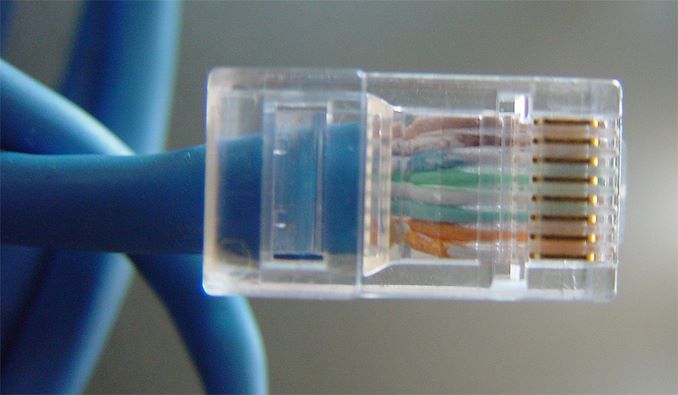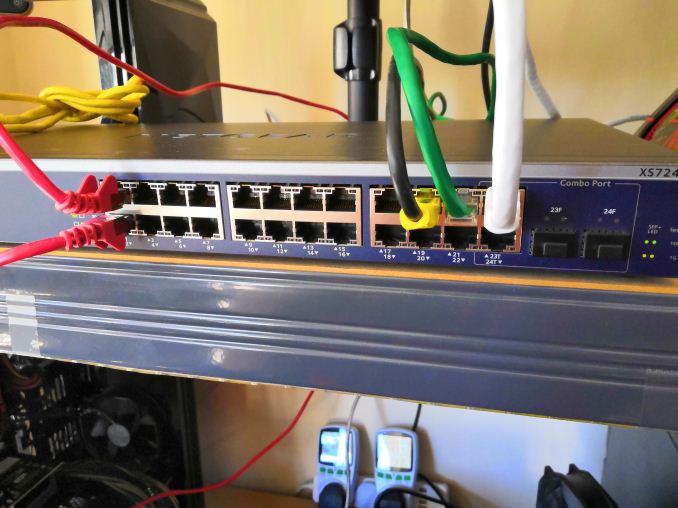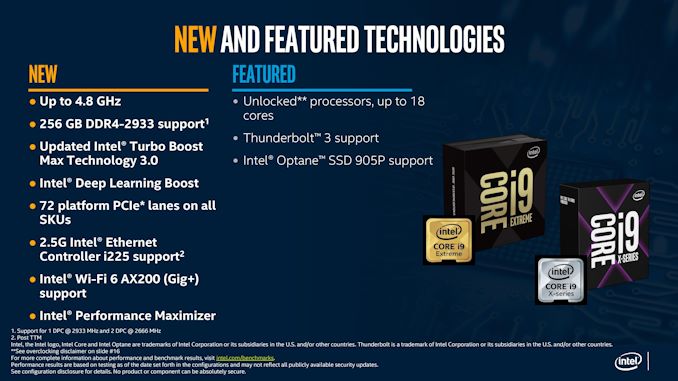Intel Quietly Mentions 2.5 GbE Ethernet Controllers
by Dr. Ian Cutress on October 3, 2019 3:00 PM EST- Posted in
- Networking
- Intel
- Ethernet
- 2.5 GbE
- i225

One of the parts that was quietly mentioned in yesterday’s Cascade Lake X-Series processor launch was support for new Ethernet controllers. Specifically it mentioned Intel’s i225 Ethernet controller range, which are rated for 2.5 GbE networking speed. This is news to us – up until this point, Intel has been relatively quiet on its ‘multi-gigabit’ Ethernet strategy (2.5GbE and 5GbE) and other companies have taken the lead.
Intel’s RJ-45 networking strategy for the last decade has been pretty simple: 1 GbE controllers everywhere, and 10 GbE controllers for enterprise, and some nice margin on the enterprise stuff. The only major update in the 10 GbE strategy in the last few years has been the upgrade from the X540 line to the X550, which moved the PCIe interface from PCIe 2.0 to PCIe 3.0. While other companies have been experimenting with multi-gigabit Ethernet solutions, Intel has been rather quiet.
The market leader in 2.5 GbE and 5 GbE controllers so far has been Aquantia, with their AQC107 and AQC108 chips (plus derivatives). Aquantia was acquired by Marvell earlier this year, and we expect those product lines to be rolled up into Marvell’s naming schemes. Aquantia has had good success with multi-gigabit Ethernet for backhaul connections and automotive, so it will be interesting to see if Marvell will keep the retail channel alive. Aquantia has been the market leader in this space for three years.
The other entrant is Realtek, who released a consumer 2.5 GbE controller earlier this year. This is getting some traction on some consumer motherboards, but is still an outside play – most OEMs are looking at Aquantia’s solution for now. We also have Rivet Networks’ E3000 solution, announced back at CES 2019.
The main barrier to 2.5 GbE and 5.0 GbE adoption has ultimately been the lack of consumer grade multi-port switches. We’ve seen some devices offer single or dual ports up to 2.5 GbE/5 GbE/10 GbE, but these can’t be daisy chained or are limited to the equivalent of peer-to-peer direct connection. Users wanting something bigger, like I did, have to look to the commercial space, such as the XS724EM which more of a multi-user office 24-port switch and costs a pretty penny.
With Intel now set to enter the market with its own 2.5 GbE controller offering, we can hope it means several things. Firstly, that Intel doesn’t see this as a threat to their 10 GbE revenues. Second, hopefully switch manufacturers take the same view, and we see more multi-gigabit Ethernet switches for mainstream customers. Thirdly, we hope that they will be widely available for motherboard manufacturers to use. Given concerns about Intel’s recent 14nm demand issues, it will be interesting to see at what rate these controllers are manufactured.
When speaking with Intel, we were told that availability of the i225 family for its OEM customers will occur later in Q4, as the company ramps up production. So we’re likely to see more of these ports in 2020.
Intel’s ARK database has pages for its i225 controller family. At the time of writing, they incorrectly state that the i225 is a 1 GbE controller – we can confirm they are 2.5 GbE controllers.
Related Reading
- Intel's Cascade Lake-X CPU for High-End Desktops: 18 cores for Under $1000
- Intel Supply in Q4: “Output Capacity up, Supply-Demand Still High”
- Marvell to Acquire Aquantia, Eying Automotive Networking Market
- Qualcomm 5G Home Broadband Reference Design Announced: Aquantia Multi-Gig Ethernet Inside
- Aquantia’s Gamer Edition AQtion AQN-107 10 GbE NIC Available
- Aquantia Multi-Gig: Single Chip USB 3.0 to 5G/2.5G Dongles Coming Soon
- Things We Missed: Realtek Has 2.5G Gaming Ethernet Controllers
- CES 2019: Rivet Networks Killer E3000, a 2.5 GbE Controller












31 Comments
View All Comments
lilkwarrior - Thursday, October 3, 2019 - link
The desktop market will always have high margins & great ROI from tech industry professionals & content producers aloneWith the price of proper quality computing. The average joe, student, and traditional professional invest in the highest quality laptop w/ perceived "desktop replacement" power they can afford & leave it at that.
Similarly, people buy the most high-end phone they can afford to remove the need to buy a lot of similar equipment.
peevee - Tuesday, October 8, 2019 - link
"The desktop market will always have high margins"The desktop market hasn't had high margins since 1985.
ikjadoon - Thursday, October 3, 2019 - link
Cost: you have any numbers to back that up?Consumer computing: last I checked, lots of offices use PCs. Even thin clients use Ethernet...
Lack of awareness: seems like a chicken-and-egg problem. How can consumers be aware of something that hasn't been ever sold to them?
Growth of mobile technologies: ....yeah, it's sure a surprise the Ethernet port isn't EOL on PCs
Wi-Fi is great and has completely changed mobility in technology. But Ethernet is a much more pervasive technology than you might be willing to admit.
//
"Intel being so low-key"? Mate, this is an Ethernet controller. What "high-key" event are you waiting for?
close - Thursday, October 3, 2019 - link
Have you noticed we live in a world where you have manufacturers organizing special events just to tell everyone what else they slapped an LED on? "This old computer fan, now with LEDs! (put us in the news please)".ABR - Friday, October 4, 2019 - link
I'd actually like more speed than 1Gb and lower latencies for backups to my NAS, remote screens, etc., but this 2 and 5Gb stuff has never gotten me that excited to upgrade my switch, go rooting out remaining underspecced Cat5 cabling, and so on. Got to be at least a 10x gain to get rolling.close - Friday, October 4, 2019 - link
Unfortunately the pricing is linear. A 10G switch is probably 10 times more expensive than an equivalent 1G switch.azazel1024 - Friday, October 4, 2019 - link
Dang, you've got Cat5 around? 2.5GbE will run fine on 5E out to 100 meters and 5GbE is Cat6 to 100 meters. So long as it is true 4 twisted pair Cat5, it'll likely run 2.5GbE too, just over only short distances (I've tried 10GbE on Cat5e at less than 10 meters distance and it worked fine in an otherwise not noisy EMI environment and 10GbE is rated at 45m for 5e and 55m for Cat6).At any rate, I'd sure love 2.5GbE. I am running 1GbE right not for my home network. 2x1GbE between my server and switch and desktop and switch and with SMB Multichannel I can easily hit 235MB/sec transfers. That said, my RAID array has a bit more performance than that. Not by much, but a little more. A single 2.5GbE link should saturate my array. Switching the dual links over should give me tons of head room for years to come. Heck, even moving over to SSDs for bulk storage if that ever happens, a pair of 2.5GbE links is a lot nicer than dual 1GbE.
2.5x faster...and even for things no requiring massive bandwidth, the latency is also 2.5x less. WiFi with 802.11ax is getting to the point that you need 2.5GbE to saturate wireless (at least at close range to the WAP). I've done some file transfer tests with 3:3 802.11ac 80MHz access points and wireless NICs and hit ~100MB/sec. That isn't quite 1GbE saturation, but it is pretty close. 802.11ax does deliver around 30% higher throughput. Which means even with 80MHz, 802.11ax to properly equipped clients is going to be limited by a 1GbE wired port.
160MHz WAPs are going to be extremely constrained by wired port speed.
Even 80MHz 802.11ax is much more likely to be with MU:MIMO on client and access point sides being part of the standard (and required this time, IIRC). MU:MIMO isn't magical, but it does make it a lot more likely and easy to leverage all of the bandwidth (minus one stream) that a WAP has, even when the clients are only 1:1 or 2:2.
Anyway, in part I am saying even for wireless clients, 1GbE is going to start being a limiting factor on the backbone soon. Maybe not out to the internet, but within a network. Slowly it will trickle out to more and more people as being a limiting factor. I am sure the number of people who have >1Gbps internet access couldn't fill a stadium today, but it is slowly increasing.
I won't do it right now in part because switch prices are so damn high and I don't have a use case where I NEED it, or it limits a lot of things. Probably my next router will have a 2.5GbE port if I were to guess (most higher end 802.11ax routers are coming with them now). Add on WAPs for my network I probably won't get until there is an option of one with a 2.5GbE port. My desktop and server and core switch I want 2.5GbE ports on them sooner rather than later, but I can wait. Almost everything else in my network can stay 1GbE.
dontlistentome - Friday, October 4, 2019 - link
2.5Gb will likely easily saturate your NAS if it's spinning rust. The way we're going with QLC speeds on SSDs, you'd be able to saturate it with 100Mb soon :).I've played with 10Gb stuff and it uses tons of power = heat, cost, noise. Not good for home use. 2.5 is a good compromise and starts the step towards higher speeds as power consumption falls. If your NAS has PCIe, get a couple of cheap SFP+ cards off ebay (~$40/£35 each) and some fibre - £20 will get you a 20m cable and SFP uses a ton less power than copper. Mikrotik make a 4x10 SFP+ plus 1x 1Gb copper switch for not much over $100.
BuckmeisterG - Thursday, October 3, 2019 - link
Is no one going to mention the pin out of that 8p8c RJ45 connector? Ignoring the subject of the article, the number 1 reason for poor network performance is poor quality or poorly installed cabling. And yes it does matter as much or more than the fancy device or switch you plug it in to.close - Thursday, October 3, 2019 - link
Well you can get 1.5Gbps with a 2.5G connection over a bad cable. You're not going to get it with a 1Gbps link over a perfect cable.